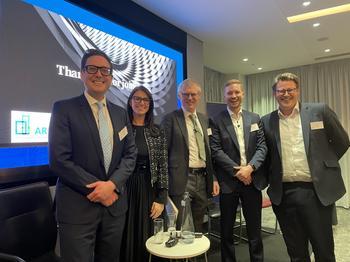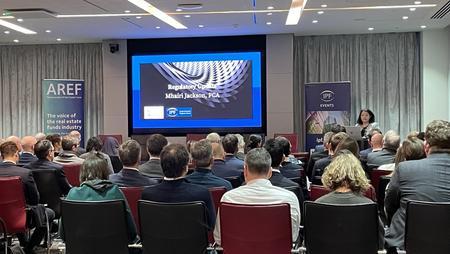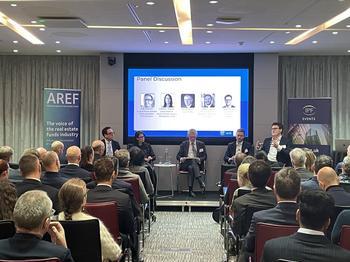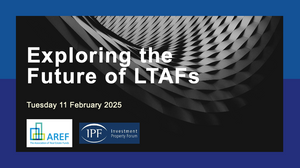Key Takeaways from Our Expert Panel Discussion

On Tuesday 11 February 2025, we hosted an engaging panel discussion on Long-Term Asset Funds (LTAFs), bringing together key industry figures to explore the evolving landscape, regulatory developments, and opportunities in private markets.
The session, moderated by John Forbes of John Forbes Consulting and hosted by Ayesha Patel from PwC, featured insights from:
- Mhairi Jackson, Asset Management Policy Manager, Financial Conduct Authority
- Tom Graham, Head of Private Markets Equity Specialists, Aviva Investors
- Christy Lindsay, Head of Sales and Private Markets Distribution, LGIM
- James Lowe, Director, Private Markets, UK Wealth, Schroders
- James Monk, Investment Director, Fidelity
Introduction by Alesha Patel, PwC
Ayesha Patel, a tax partner at PwC, representing the hosts set the scene outlining the rationale for the introduction of the long-term asset fund (LTAF) in 2021 to allow investments in long term illiquid assets by defined contribution pension schemes and retail investors. The first LTAFs were launched in 2023, and there are now 10 up and running, with strong indications that there are many more in the pipeline. Ayesha flagged the resources available from AREF, specifically a model LTAF Instrument of Incorporation for LTAFs in the form of an open-ended investment company (OEIC) and a model LTAF Co-Ownership Deed for LTAFs in the form of an Authorised Contractual Scheme (ACS).
Regulatory Developments by Mhairi Jackson
Ayesha was followed by Mhairi Jackson, Asset Management Policy Manager, Financial Conduct Authority (FCA), who covered the regulatory developments for the LTAF and what the FCA are currently seeing coming through the FCA approval gateway. Mhairi started by providing some background as to why the Department of Work and Pensions (DWP) saw the unlocking barriers to investment in illiquid assets would improve long-term outcomes for scheme members. She outlined the role of the FCA and the Productive Finance Working Group in developing the LTAF. As well as designing the LTAF itself, the FCA worked with the DWP on the development of the Value for Money framework and removing performance fees from the DC pension Charge Cap. Mhairi outlined the key features of the fund, with a particular focus on those areas that the FCA are keen to understand during the authorisation process. The management of any liquidity mismatch is clearly a high priority.

Mhairi flagged a number of areas that the FCA are considering where further consultation and change is anticipated:
- Looking with HM Treasury at the uncapped liability position of external valuers as there is a recognition that the market is not working in practice;
- Working with the Depositary Association to resolve issues from depositaries holding title to non-custodial assets;
- Reform of the Permitted Links rules.
Current State of LTAFs
It is in the public domain that the FCA have authorised 10 LTAFs with 19 sub-funds. There are more that have been approved by the FCA but are not yet in the public domain. These cover a wide variety of different private asset classes. For managers considering launching an LTAF, Mhairi stressed the importance of early engagement with the FCA. On average, it is taking three months to authorise an LTAF.
Panel Discussion on LTAFs
John Forbes then chaired a panel consisting of Tom Graham, Head of Private Markets Equity Specialists, Aviva Investors, Christy Lindsay, Head of Sales and Head of Private Markets Distribution Legal & General Investment Management (LGIM), James Lowe, Director, Private Markets, UK Wealth, Schroders, James Monk, Investment Director, Fidelity.
All the firms represented on the panel have launched LTAFs so the panel started by outlining why they have chosen to launch LTAFs. This has been primarily to unlock investment by DC default funds, although James Lowe flagged that Schroders also sees the LTAF as an investment route for its wealth channel. These are currently separate, with OIEC-based funds for individual investors and ACS-based funds for institutional investors.
DC pension schemes can be contract-based, regulated by the FCA and trust-based, regulated by the Pensions Regulator (TPR) and DWP. Although there are differences, these are manageable and largely temporary as the FCA and TPR/DWP work towards comprehensive alignment. The LTAF should therefore be an attractive option for default fund investment for both contract-based and trust-based schemes.
All the panellists agreed that the education of employers and trustees as to why and how to invest in illiquid assets is key. This has been a major focus for the industry for the last three years. It has been challenging, at least in part because investment by DC pension schemes is so heavily intermediated, and there is not always full transparency. It is not just understanding the underlying illiquid, private assets.
The schemes have been used to invest through a daily-trading model, so understanding the new structures, including the LTAF, is also hugely important, as is the shift to looking at value for money rather than just cost. The FCA and TPR are working on the Value for Money (VfM) framework for pension default funds, the publication of which is imminent. AREF and the IPF are also working on an educational paper for DC schemes on investing in real estate as an asset class.

Another area on which there was consensus was the importance of investment in technology. The most immediate need is improving platforms which have been designed for daily-trading. Accommodating different notice periods, different redemption restrictions and different fee terms is challenging. Onboarding LTAFs on to platforms has been hugely time consuming. There is a bit of a “chicken and egg” situation. Platform providers are reluctant to invest the significant cost of enhancing the platforms until they see evidence of successful LTAFs wanting to use the platforms whilst there is a reluctance to launch new LTAFs without the certainty that the platforms can deliver. Hopefully the current activity is helping to unlock this. Looking further ahead, more profound technological change will be needed to meet the expectations of sophisticated, younger scheme members.
It was apparent from the panel discussion that different investment models are evolving. Some managers view the route to delivering VfM as achieving scale and minimising costs. Investment will primarily be through in-house managers with third parties used to fill any gaps. Where third-party managers are used, scale allows the negotiation of heavily discounted fees. Others see VfM being achieved by investing through best-in-class third party managers selected on the basis of investment performance. The model is therefore much closer to a traditional fund-of-funds model. As a consequence of this, the underlying investments may also vary significantly, for example James Monk of Fidelity stressed that their LTAF would be investing in third-party, closed-ended funds.
Liquidity terms varied from LTAF to LTAF. Regulation requires a minimum 90 day notice period, but this may be longer and LTAFs will typically have other liquidity management tools to reflect the illiquidity of the underlying assets. This is something at which the FCA look very closely during the authorisation process. This includes liquidity stress testing. There is an ongoing discussion as to whether fixed notice periods, as stipulated in regulation, really is the most appropriate approach to liquidity management. Not all managers manage liquidity primarily in the LTAF.
Liquidity may be managed in multi-asset vehicles above the LTAF which hold a significant proportion in liquid assets.
It was also emphasised that there is a difference between managing liquidity on a day-to-day, “business as usual” basis and protecting investors in the event of extreme events such as those seen during the Global Financial Crisis (GFC). Nobody wants to be forced-sellers of assets at a haircut price in order to meet redemptions.
Investment funds for defined benefit schemes did a lot of work on this following the GFC, so there are plenty of examples to follow. From both a valuation and a liquidity perspective, it was felt to be somewhat more straight-forward than less stablished private assets.
When investing with third-party managers, Christy Lindsay noted that LGIM look at very large funds with different types of other investors such as foreign pension funds and sovereign wealth funds. By holding only a small percentage in large funds with investors who might behave differently, the view was that this reduced the risk of not being able to redeem when desired. The other side of the equation is that liquidity can also be managed by combining cash holdings with redemption gates. The example was cited of holding 15% cash with a 5% redemption gate per quarter.
This gives a window of three quarters to meet redemptions, and there may also be the possibility to suspend beyond this. Liquidity has also been helped by the development in recent years of the secondary market for fund units. This creates liquidity for both units in the LTAF and the underlying funds in which it has invested. The secondary market also provides an opportunity for LTAFs to invest and deploy capital quickly.
Nature of Underlying Investments
This prompted a broader discussion on the nature of the underlying investments. Two important areas where discussed:
- LTAFs are investing in open-ended funds and closed-ended funds through the primary and secondary market as well as direct assets. There may also be some holdings in listed securities. In terms of LTAFs investing in real estate funds, the Reserved Investor Fund or RIF may be an attractive onshore vehicle.
- UK real estate needs to compete with a broad range of private assets in the UK and internationally.
Asset managers need to decide whether they want or need to launch a LTAF or if they instead will seek to create the “best-in-class” fund into which LTAFs will invest. Asset managers must focus on bringing their best capabilities to the market rather than tailoring offerings solely to DC requirements.
Final Thoughts
Overall the sentiment was that from both a DC and wealth perspective, interest in the LTAF is increasing. There was a general view that more LTAFs coming to market would ensure that momentum is maintained and overall confidence in the model will be improved. The direction of travel from DB to DC is only in one direction so this is going to be increasingly important. The lessons from DC can then be applied in wealth
Thank you to our speakers and attendees for an insightful discussion. We look forward to continuing the conversation as the market develops.
Related Links:
Slides:

Recording/Podcast:
The recording and podcast of this event are avaialble to AREF members only. Please click the button below to log-in to view:

Photos:



Enquiries:
If you would like to talk to us about anything about this topic, please email us in the first instance at [email protected].

